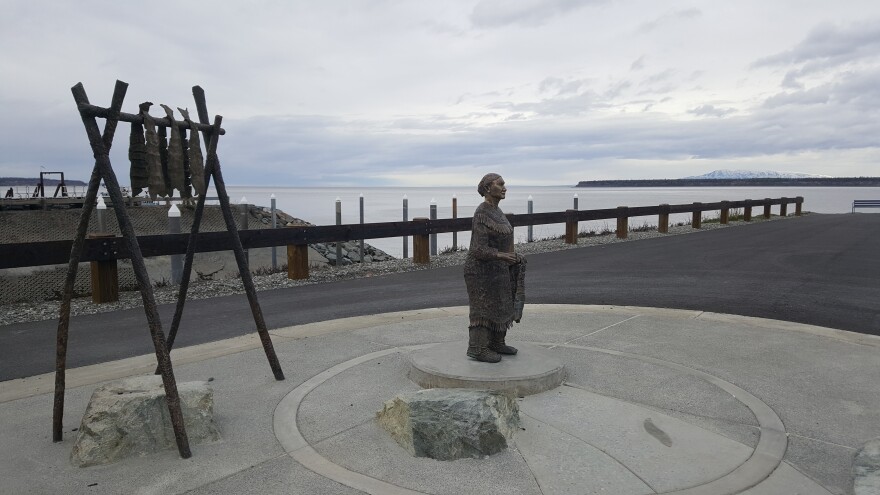
Near downtown Anchorage’s Ship Creek, an art installation pays tribute to Dena’ina traditions and culture. And at the center is the bronze representation of one of its matriarchs.
On Small Boat Launch Road, Grandma Olga stands ever vigilant – watching over an area that was a traditional fish camp for the Dena’ina people here -- in what’s present-day Anchorage.
“It feels like she's integrated into the environment and in a living way,” said artist Joel Isaak, who spent more than a year working on the project. "Here is a living person representing living people in a way that we still see ourselves as Dena'ina people."
Isaak lives and works on the Kenai Peninsula in Kenai and Soldotna. He is a graduate of University of Alaska fine arts program and holds a master of fine arts in sculpture.
Though Olga’s bronze likeness is comparatively short in stature, she played a big role in Dena’ina society.

Born in 1875, “Grandma” Olga Nicolai Ezi was originally from Tyone Lake and Copper Center regions. She married a Dena’ina leader of the upper Cook Inlet in 1896.
Olga and her husband raised five children and led a hard-working subsistence lifestyle and ferried supplies from Anchorage to area villages. The couple is credited with settling into Eklutna and establishing much of the tribal lineage.
Isaak says the project to honor the family’s matriarch began a couple of years ago.
"Eklutna put out an RFP, a request for proposal, for the Olga Ezi statue and the fish camp that she would be with. That was a public call for art that I put together a proposal for and Eklutna selected me to do that."
For Isaak the project would bring together his love of bronze sculpture and Dena’ina Athabascan heritage. It would also give him a chance to represent fish skin in bronze metalwork.
“I really like her fish skin boots, because I've been wanting to make fish skin boots out of bronze for quite a while. That was the first object that I made out of fish skin was boots with moose hide soles, so those just make me really happy to see them in metal.”

You can really see the detail on the boots, too – individual fish scales, seam lines -- even the ties that wrap around her ankles.
Isaak used photos of Olga, and pictures of her living descendants to create the elder’s likeness – first in clay and wax, and then in bronze.
"The wax is then cast in bronze and cleaned up using files and sandpaper and grinders and Dremel tools as a final tooling to make it look like her."
The whole installation includes Olga, a fish trap, a fish rack and bronze silhouettes of salmon laid into the concrete. From start to finish, Isaak says the work took about two-and-a-half years. The finishing pieces were installed in November.
“Olga is looking out, it was very intentional where she is looking out, she's looking out over the traditional, customary dip netting site there at Ship Creek. That's part of the narrative of what she's doing is that's a fish camp site. And now there's a port or a dock on top of it.”
Southeast of where Olga is standing is another sculpture.
"There's a Captain Cook statue that's up in Anchorage, kind of downtown that her back is kind of to," Isaak said. "So it just kind of is an interesting relationship between those two figurative statues in Anchorage -- where you have one male colonial icon figure, ... and then you have Olga who is representative of the matrilineal way that Dena'ina society is, is structured and organized. You have an elder who is living with the land versus someone who is conquering it."

For Isaak the installation has a much deeper significance to him.
"What I was trying to do was represent living people and our life way that even though it's been heavily interrupted, has not stopped," he said. "That we're still here as Dena'ina people and what does it look like to be Native in an urban environment and that kind of clashing-slash-still living in harmony with the land even though the concrete is being put over top of it."
Editor's note: Native Voice One’s Bob Petersen contributed to this report.





